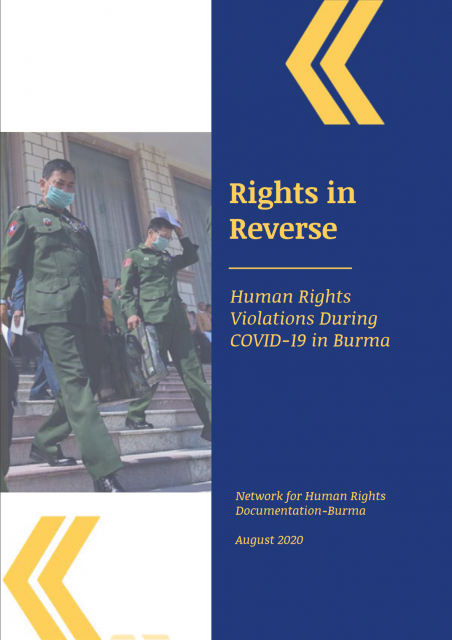Rights in Reverse: Human Rights Violations During COVID-19 in Burma


Overview
As the COVID-19 pandemic spread rapidly at the beginning of the year, the National League for Democracy (NLD) led government and military reassured the country’s citizens that they had nothing to worry about. The blanket denial served its purpose until the inevitable on 23 March 2020, when the NLD government confirmed the first two cases of COVID-19 in the country. Since then, cases have steadily continued to rise. The Burma government has taken several steps including forming an emergency task force with military and civilian ministries to support measures around law enforcement and stability and to expand government efforts to respond to the pandemic.
As of 1 August 2020, the National Reconciliation and Peace Center (NRPC) has provided 50-million Myanmar Kyat ($36,500 USD) to members of the Arakan Liberation Party and their families amid the COVID-19 crisis. The NRPC has also provided monetary support to other ethnic armed organizations (EAOs) who have signed the Nationwide Ceasefire Agreement (NCA) including the Karen National Union/Karen National Liberation Army-PC, the Democratic Karen Buddhist Army, the Lahu Democratic Union, the New Mon State Party, the Chin National Front, the All Burma Students’ Democratic Front and the Pa-O National Liberation Army. All groups received between 25 million and 100 million Myanmar Kyat to support COVID-19 relief.
However, there are many vulnerable groups in Burma who cannot access or afford basic health infrastructure. ND-Burma defines the most vulnerable people as women and children, the elderly, individuals with physical and mental disabilities, and those living in conflict zones (often remote areas far from health infrastructure). As the pandemic continues to spread, civilians in conflict affected areas have compromised access to treatment, information and support. With no end to the hostilities in sight, the prospects on the ground for preserving civilian safety have become even more difficult.
The economic consequences of COVID-19 must also not be overlooked. According to the Ministry of Labor, Immigration and Population, approximately 250 000 Burma workers have lost their jobs as a result of the crisis, both locally and abroad as many businesses have been forced to close. At the end of April, the NLD government responded to the economic impacts by unveiling their COVID-19 Economic Relief Plan (CERP), which aimed to distribute 287 billion Myanmar Kyat (US $210 million) in food and cash to the population. Under this plan, nearly 3500 businesses were provided with a total of 100 million Myanmar Kyat (US $74 million).
While these efforts are commendable, Burma’s flaws in governance and coordination have been exposed in their delays to responding to the first threat of the pandemic.
This short report is an assessment of the human rights situation in Burma since the first confirmed COVID-19 case mid-March. The data and analysis in this report are based on the answers to 23 questions from the following ND-Burma organizations: All Arakan Students’ and Youths’ Congress (AASYC), Future Light Center (FLC), Association of Human Rights Defenders and Promoters (HRDP), Human Rights Foundation of Monland (HURFOM), the Ta’ang Women’s Organization (TWO), Ta’ang Students and Youth Union (TSYU), the Tavoyan Women’s Union (TWU) and the following affiliate member organizations: Chin Human Rights Organization (CHRO), East Bago-Former Political Prisoners Network (FFPS-EB) and the Pa-O Youth Organization (PYO).
Download full report in English.
Download full report in Burmese.
၎
င
၎
၎
၎
င
၎
၎

